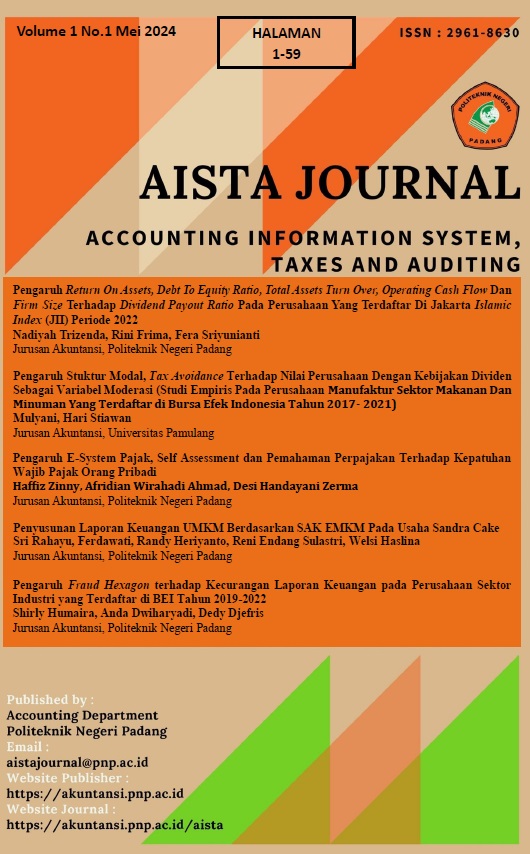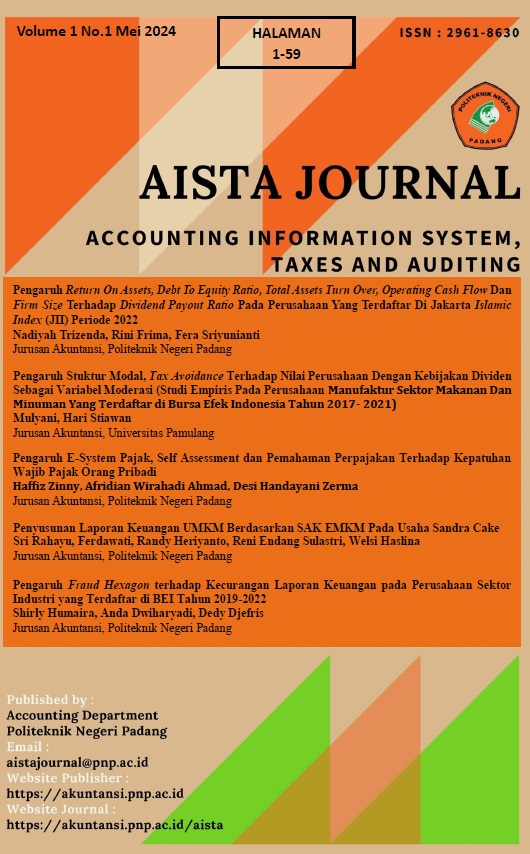Pengaruh Fraud Hexagon terhadap Kecurangan Laporan Keuangan pada Perusahaan Sektor Industri yang Terdaftar di BEI Tahun 2019-2022
DOI:
https://doi.org/10.30630/aista.v3i1.66Keywords:
Fraud, Fraud Hexagon, Kecurangan Laporan KeuanganAbstract
This study aims to investigate the influence of the fraud hexagon, comprising stimulus, opportunity, rationalization, capability, arrogance, and collusion, on instances of financial statement fraud within the industrial sector listed on the Indonesia Stock Exchange from 2019 to 2022, involving 48 companies. The components of the fraud hexagon are operationalized as follows: financial targets represent the stimulus, nature of industry proxy for opportunities, auditor changes indicate rationalization, director change signify capabilities, the frequent presence of CEO pictures reflects arrogance, and collaborations with government projects represent collusion. Through purposive sampling, 33 companies meeting specific criteria were selected, resulting in a total of 132 observations. Logistic regression was employed for data analysis, with IBM SPSS 26 used for data processing. The study's findings reveal that financial targets, nature of industry, auditor changes, director change, and the frequency of CEO pictures do not exert influence on financial statement fraud. However, collaboration with government projects is identified as a factor impacting financial statement fraud.
References
(ACFE), A. of C. F. E. (2022). Report To the Nations 2022.
Agustina, R. D., & Pratomo, D. (2019). Pengaruh fraud pentagon dalam mendeteksi kecurangan pelaporan keuangan. Jurnal Ilmiah MEA (Manajemen, Ekonomi, & Akuntansi), 3(1), 44–62.
Alifa, R., & Rahmawati, M. I. (2022). Analisis Teori Hexagon Fraud sebagai Pendeteksi Financial Statement Fraud. Jurnal Ilmu Dan Riset Akuntansi (JIRA), 11(6), 1–25.
Aprilia, A. (2017). Analisis Pengaruh Fraud Pentagon Terhadap Kecurangan Laporan Keuangan Menggunakan Beneish Model Pada Perusahaan Yang Menerapkan Asean Corporate Governance Scorecard. Jurnal ASET (Akuntansi Riset), 9(1), 101.
Association of Certified Fraud Examiners (ACFE). (2018). Report To the Nations 2018 Global Study on Occupational Fraud and Abuse.
Bambang Leo Handoko. (2021). Fraud Hexagon Dalam Mendeteksi Financial Statement FrauD. 5(2), 176–192.
Bawekes, H. F., Simanjuntak, A. M., & Christina Daat, S. (2018). Pengujian Teori Fraud Pentagon Terhadap Fraudulent Financial Reporting (Studi Empiris pada Perusahaan yang Terdaftar di Bursa Efek Indonesia Tahun 2011-2015). Jurnal Akuntansi & Keuangan Daerah, 13(1), 114–134.
cnbcindonesia.com.(2021).https://www.cnbcindonesia.com/market/20210726191301-17-263827/deretan-skandal-lapkeu-di-pasar-saham-ri-indofarma-hanson/3
Cressey, D. R. (1953). Other people’s money; a study of the social psychology of embezzlement.
Howarth, C. (2011). The Fraud Pentagon: Considering the Five Elements of Fraud. The CPA Journal.
Irianto, G., & Novianti, N. (2019). Dealing with fraud. Universitas Brawijaya Press.
Jensen, and W. H. M. (1976). Theory of the Firm: Managerial behavior, agency costs and ownership structure. Journal of Financial Economics, 3 : 3.
KPK. (2021). Laporan Tahunan 2021.
Larum, K., Zuhroh, D., & Subiyantoro, E. (2021). Fraudlent Financial Reporting : Menguji Potensi Kecurangan Pelaporan Keuangan dengan Menggunakan Teori Fraud Hexagon. 4(1), 82–94.
Lou, Y., & Wang, M. (2009). Fraud Risk Factor Of The Fraud Triangle Assessing The Likelihood Of Fraudulent Financial Reporting. 7(2), 61–78.
Nurardi, D. S., & Wijayanti, R. (2021). Determinan Financial Statement Fraud Dengan Analisis Fraud Hexagon Model (Studi Empiris pada Perusahaan Sektor LQ 45 yang Terdaftar di Bursa Efek Indonesia Periode II Agustus-Januari 2016-2019). The 13th University Research Colloqium 2021, 2019(3), 430–441.
Oktarigusta, L. (2017). Analisis Fraud Diamond Untuk Mendeteksi Terjadinya Financial Statement Fraud Di Perusahaan (Studi Empiris Pada Perusahaan Manufaktur Yang Terdaftar Di Bei Tahun 2012-2015). Jurnal Manajemen Dayasaing, 19(2), 93–108.
Pamungkas, SE., M.Si., Akt., CA., CIBA, I. D., & SUKMA, S. F. (2022). Menguji Potensi Kecurangan Pelaporan Keuangan Dengan Menggunakan Teori Fraud Hexagon. Jurnal Akuntansi Dan Bisnis Krisnadwipayana, 9(3), 864.
Rahmanti, M. M., & Daljono, D. (2013). Pendeteksian Kecurangan Laporan Keuangan Melalui Faktor Risiko Tekanan dan Peluang (Studi Kasus pada Perusahaan yang Mendapat Sanksi dari Bapepam Periode 2002–2006). Fakultas Ekonomika dan Bisnis.
Sari, S. P., & Nugroho, N. K. (2021). Financial Statements Fraud dengan Pendekatan Vousinas Fraud Hexagon Model: Tinjauan pada Perusahaan Terbuka di Indonesia. Annual Conference of Ihtifaz: Islamic Economics, Finance, and Banking, 409–430.
Sekaran, U., & Bougie, R. (2016). Research methods for business: A skill building approach (7th Editio). John Wiley & Sons.
Septriani, Y., & Desi Handayani, dan. (2018). Mendeteksi Kecurangan Laporan Keuangan dengan Analisis Fraud Pentagon. 11(1), 11–23. http://jurnal.pcr.ac.id
Setiawati, E., & Baningrum, R. M. (2018). Deteksi Fraudulent Financial Reporting Menggunakan Analisis Fraud Pentagon : Studi Kasus Pada Perusahaan Manufaktur Yang Listed Di Bei Tahun 2014-2016. Riset Akuntansi Dan Keuangan Indonesia, 3(2), 91–106.
Setyono, D., Hariyanto, E., Wahyuni, S., & Pratama, B. C. (2023). Penggunaan Fraud Hexagon dalam Mendeteksi Kecurangan Laporan Keuangan. Owner, 7(2), 1036–1048.
Siddiq, F. R., & Suseno, A. E. (2019). Fraud Pentagon Theory Dalam Financial Statement Fraud Pada Perusahaan Terdaftar di Jakarta Islamic Index (JII) periode 2014-2017 (Perspektif F-Score Model). Jurnal Nusantara Aplikasi Manajemen Bisnis, 4(2), 128–138.
Skousen, C. J., & Twedt, B. J. (2009). Fraud score analysis in emerging markets. Cross Cultural Management: An International Journal.
Tessa, G. C., & Harto, P. (2016). Fraudulent financial reporting: Pengujian teori Fraud Pentagon pada sektor keuangan dan perbankan di Indonesia. Fakultas Ekonomika dan Bisnis.
Ulfah, M., Nuraina, E., & Wijaya, A. L. (2017). Pengaruh Fraud Pentagon Dalam Mendeteksi Fraudulent Financial Reporting (Studi Empiris Pada Perbankan Di Indonesia Yang Terdaftar Di Bei. Forum Ilmiah Pendidikan Akuntansi, 5(1), 399–418. Fraud, Fraud Pentagon, Fraudulent Financial Reporting
Vousinas, G. L. (2019). Advancing theory of fraud: the SCORE model. Journal of Financial Crime.
Wolfe, D. T., & Hermanson, D. R. (2004). The fraud diamond: Considering the four elements of fraud.
Zulfa, K., & Bayagub, A. (2018). Analisis elemen-elemen fraud pentagon sebagai determinan fraudulent financial reporting. Keberlanjutan: Jurnal Manajemen Dan Jurnal Akuntansi, 3(2), 950–969.








